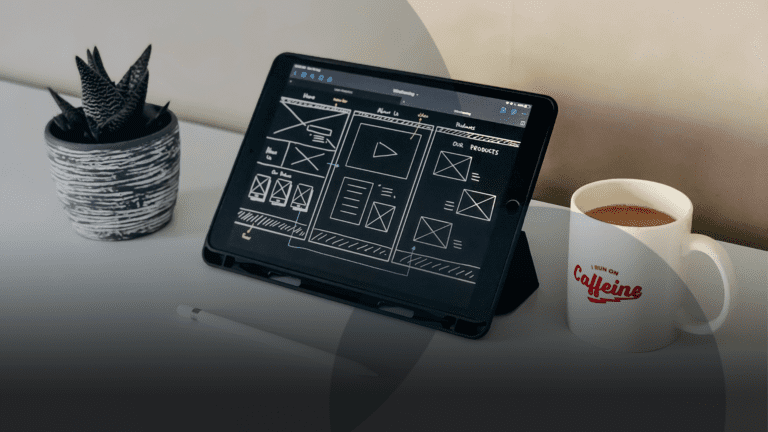
Abby Webb
Head of Search & Content
Abby heads up our SEO and content campaigns, with a strong background in copywriting, content and paid search marketing.

Landing pages are one of the most important, yet overlooked, parts of a marketing campaign. Here we explore exactly what a landing page is, how they work, and how to create them for success.
Landing pages are at the centre of an effective marketing campaign. They’re often the first page that a new customer will visit on your website, after interacting with one of your ads. Yet they’re also one of the most overlooked elements of a campaign.
While it’s important to spend time creating compelling social or search ads that encourage your ideal customer to your website, it’s the page they land on (hence “landing page”) that ultimately convinces them to take action, whether that’s to enquire about your service, sign up for your course or join your email newsletter.
This guide will walk you through what a successful landing page looks like, so you understand what a landing page is and how it works. Let’s start with the basics:
A landing page is a standalone page on your website that is specifically built for a marketing or lead generation campaign to convert visitors into customers.
Landing pages (or “squeeze pages”, “splash pages” or “opt-in pages” as they are also known) are completely separate from all your other web pages, and they are deliberately kept out of your website navigation, as their purpose is to encourage the visitor to take action on one particular activity. They usually feature a form for the visitor to fill out in exchange for your offer – whether a downloadable, a call, course access.
Landing pages are different from other pages on your website because they are specifically designed to convert visitors from your marketing activity, like paid social or paid Google Ads campaigns, rather than conveying lots of information as you would on other pages on your website.
Why is this? Well, landing pages are created with one goal in mind – to convert your target audience into customers from your marketing activity – which is why they work so well.
The rest of your website is designed for many goals, and usually for many different audiences, depending on how your business works.
Landing pages appear deceptively simple to create because they only have one purpose. But it’s not as easy as that! While it’s true that landing pages are often minimal in design – as the fewer distractions on the page, the better – every single component on them has to be carefully considered.
In a nutshell, the ideal landing page includes:
The main reason you wouldn’t use an existing page on your website for your paid advertising campaign is because they are often very cluttered. Unlike landing pages, service and product pages are designed with SEO in mind to help the page show up highly in Google’s organic search results, so while there’s plenty of valuable content on these pages, there are also lots of distractions away from the main goal.
Instead, your landing page needs to be easy for your target audience to follow, with the main focus on the call to action and the form. Ideally, you’ll also want to remove your website navigation and footer on your landing page, to reduce the chances that your visitor will click off your page and go elsewhere.
Tip: It’s best practice not to index your landing page, so it won’t get displayed in the organic search results.
Match your headline and call to action to the ads that are driving traffic to your landing page. This might mean that you’ll want to write multiple landing pages to best complement your ads.
For example, if the call to action in your ad is to “Download the guide”, then you’ll want to use “Download the guide” as your call to action text on your landing page. By doing so, you’ll make your landing page highly relevant to your offer and create a sense of consistency for your visitor. Keeping your headlines and calls to action consistent with your ad copy could improve your quality or relevance score in your ads platform, which could help lower the cost per click of your ad!
Also, make sure your landing page is only designed to sell one offer. Including multiple offers on your landing page can decrease conversions by up to a staggering 266% according to TechJury, so it’s wise to have a dedicated landing page for each service or offer you’re promoting. The more relevant the content on this page to your ad copy and your keywords, the better your ads will perform.
Only 16% of people read a webpage word-for-word, while 79% of people only skim the page they’re on, according to the Nielsen Norman Group, so it makes sense that your landing page isn’t full of content that just won’t be read.
Instead, you want to write a paragraph or two of seriously compelling content that describes the benefits of your service or offer, in a way that speaks directly to your target audience.
If you’re not sure on what to write here, take a look at previous reviews you’ve had for the offer you’re promoting (or a competitor’s reviews, if your offer is new). Reviews are a gold mine for adjectives and phrases you can include in your landing page copy. And they’ll help you understand which aspects of your product or service are important to your customers, so you can prioritise them when it comes to writing your description. If you often have the same questions asked about this particular service, you can include that in your copy too.
Images help bring context to your offer and have been proven to improve conversion rate on landing pages. The key is choosing the right image. Lifestyle images work well, as do photos of actual humans – ideally those using your product or service. If you have a few images to choose from, why not A/B test them?
Even better, try embedding a video to your landing page. According to Vidyard, 54% of landing pages in 2020 featured video. Talking head or demonstration videos are great when your offer is a little more complex, or if the product or service is hard to understand.
Testimonials and reviews play a crucial role on a landing page. They help build trust with the visitor, and increase the likelihood that they’ll take action. In fact, according to BrightLocal, positive reviews make 91% of consumers more likely to use a business, and the average consumer reads 10 reviews before feeling able to trust a local business. Plus, Hubspot shares that 36% of top landing pages feature testimonials, while 11% have reviews.
It doesn’t matter whether you’ve collected reviews yourself, built case studies on your website, or have reviews on Facebook, Google or TrustPilot. If you’ve got them, share them!
Help ease any nervousness that a potential customer might have by sharing other forms of social proof on your landing page to reinforce a sense of trust. Other forms of social proof include logos of qualifications, security badges, logos of businesses you’ve worked with, awards you’ve won or guarantees that you promise as part of your offer (like a money-back guarantee).
The most important part of any landing page is the contact or lead generation form itself, so you can capture the information you need from the visitor.
Ask only for the information you really need. If you don’t need their address or phone number at this stage, don’t ask for it. The more information you ask for, the less likely it is that the form will be completed.
Then test! Double-check the form is working and that you’re receiving form submissions before you go live. If there is an automated sequence after the form is submitted, such as an email with a lead magnet, make sure it’s working properly too. There’s nothing worse than spending on ads before realising that you’re not actually receiving any information, or that your lead hasn’t received the offer you promised.
Landing page speed matters. It makes sense – the quicker your page loads, the more likely it is that your visitor will stick around and take action.
Google agrees:
53% of visits are abandoned if a mobile site takes longer than three seconds to load. That’s a big problem.
Google
In 2018, Google announced that it uses speed as a landing page factor for both organic and paid search campaigns. A slow page speed can also affect your Landing Page Experience, one of the metrics Google Ads uses to assess your Quality Score (and therefore, how much you should pay per click). And, according to TechJury, a one-second delay in your landing page loading can reduce conversions by 7%.
So once you go live with your landing page, make sure you test the page speed. Try loading the page from your desktop and mobile to get a sense of the speed, then use a tool like Lighthouse and PageSpeed Insights to properly assess and diagnose any issues.
Page load speeds are commonly due to things like using high-resolution images, so compress your images if you haven’t already, as this can make a big difference. If you’ve got lots of widgets and plugins on the page, review whether they’re all necessary and add to the visitors’ experience. If not, remove them and review the speed again. Also, using a service like Cloudflare can really help speed up content delivery.
Once you’ve built your landing page and have it up and running, keep a close eye on the activity taking place on the page. Analytics is your friend here, so make sure you’re tracking activity on your landing page (and the rest of your website!).
To understand whether your landing page is bringing in valuable traffic, you’ll want to focus on metrics like goal completions, number of sessions, bounce rate, average session duration and page speed.
Not sure what you’re looking for? Check out our handy Google Analytics glossary.
Once you’ve got an idea of how your landing page is performing – and depending on your advertising budget – you can run an A/B test. Create multiple versions of your landing page, test different elements, and see how they affect your conversion rate.
What could you test?
Hopefully, by analysing the performance of your landing page so far, you’ll be able to make a list of elements to test out, but here are some common A/B test scenarios:
Keep monitoring and testing, and make a note of the winning elements, so you can recreate them in your landing pages for future ad campaigns.
Here are some key stats to bear in mind when creating your landing pages:
The main takeaways here are to only feature one offer, include video where possible, make it easy to read, share reviews and testimonials if you have them available, and make sure your page loads as quickly as possible. Follow these tips and you’ll be well on your way to a successful landing page.
Have any questions about landing page optimisation? Want help with your ad campaigns? We can help you with both! Email me at [email protected].

Head of Search & Content
Abby heads up our SEO and content campaigns, with a strong background in copywriting, content and paid search marketing.
View my other articles and opinion pieces below
This short guide will teach you how to track your marketing campaigns using UTM parameters. Also referred to as a custom URL, a UTM tag is a customised snippet of text (called a parameter) that is added at the end of a website address. This UTM tag allows you to track and identify the traffic […]

When designing their website, some companies don’t give their homepage much thought. After all, shouldn’t it be the easiest page to design? You’ve got a blank slate – you can put anything and everything about your business on there. What could go wrong? But bad website homepage design is everywhere – and it has a […]

When it comes to site traffic, your visitors’ journeys are just as important as their destinations. It’s great getting new visitors to your site. However, if you don’t understand how and why they got there, you’re missing half of the picture. Understanding your visitors’ journeys will help you optimise your site’s pages, attract more visitors […]

AI has taken the world of digital marketing by storm. We’ve seen AI being used in Google Analytics, it’s changing the way we approach content marketing and what we post on social media. Now, it’s the turn of Google Ads. The platform already includes a range of AI features and, at Google Marketing Live, recently […]
